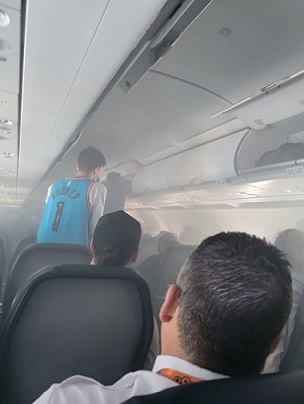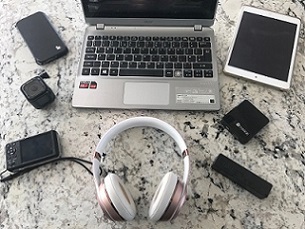 Smoke filling the passenger cabin on a Spirit Airlines flight to Orlando after a lithium battery fire in an overhead locker. Photo by Joseph Fleck @nottashow
Smoke filling the passenger cabin on a Spirit Airlines flight to Orlando after a lithium battery fire in an overhead locker. Photo by Joseph Fleck @nottashow
 All these electronic devices are powered by lithium batteries
All these electronic devices are powered by lithium batteries
 A pilot holding an AvSax lithium battery fire mitigation bag
A pilot holding an AvSax lithium battery fire mitigation bag
 AvSax thermal fire mitigation bags - also known as burnbags - means planes can continue their journey safely
AvSax thermal fire mitigation bags - also known as burnbags - means planes can continue their journey safely
A major news report in the USA has revealed that some airlines still don’t have specialised fire containment bags to deal with lithium battery fires on board aircraft even though the number of incidents is increasing.
CBS News did a special report on the dangers of lithium batteries on aircraft after discovering there is, on average, at least one lithium battery incident on a passenger plane somewhere in the US every week.
The investigation by CBS reporter Stephen Stock revealed that the airlines’ regulating organisation in the United States, the Federal Aviation Administration (FAA), still does not require aircraft to carry lithium battery thermal containment bags and has no test standards or mechanisms to approve them.
But it clearly realises the risk by adding: “The FAA has no objection to the use of the various commercially manufactured containment products.”
Some pilots think all passenger aircraft should carry the containment bags – the best-known is AvSax - which are sometimes called burn bags.
Dennis Tajer from the Allied Pilots Association simply says: “Make it the rule.”
And when Stephen Stock asks Secretary Pete Buttigieg from the US Department of Transportation if planes should be required by the FAA to carry the bags, he said: “That’s exactly what we’re working on right now. Any time we’re going to impose by law a certain technology or a certain strategy we need to make sure that it’s appropriate, that it’s informed by the right data. But, clearly, we need to make sure we continue taking steps that are going to contain any kind of hazard here.”
The CBS report reveals that in the last five years the number of incidents of lithium-ion batteries overheating or catching fire on planes has increased by more than 40%. There will be many more incidents happening worldwide but safety organisations – such as the Civil Aviation Authority in the UK – don’t make such incidents public.
The batteries power all our everyday personal electronic items such as cell phones, laptops, iPads, vapes and even headphones.
AvSax won the Queen’s Award for Enterprise in the UK for its innovation – the highest award any business can get.
They are now on board around 16,750 aircraft operated by more than 100 airline companies worldwide, including some of the best-known names in the aviation industry. AvSax have been deployed in action at least 33 times on board aircraft since 2017 and on every occasion the aircraft was able to continue safely to its destination with no need to divert or make an emergency landing.
The CBS news report showed how potentially dangerous thermal batteries can be by blowing one up in the fire research laboratory at the University of Texas in Austin.
They did this by heating it up and then adding a spark to it.
CBS reporter Stephen Stock said: “The explosion was so loud, so forceful and so quick it took us by surprise.”
The university’s research director Ofodike Ezekoye is worried when this happens on a passenger aircraft cruising at 30,000ft. He said: “It can cause an accident that the aircraft crew and the airplane cannot manage. It’s literally life or death.”
Ofodike described lithium batteries as “uniquely hazardous” as the fires are within the battery cells so the fuel, oxygen and heat are all contained within the cell. This means they can keep flaring up and lithium batteries can even burn underwater.
When it overheats, a lithium battery goes into a chemical process called thermal runaway and when this happens it can produce enough heat – up to 900°C (1652°F) – to cause adjacent cells to overheat.
This can cause a lithium battery fire to flare repeatedly and they are then very difficult to put out which is why it must go into a lithium battery fire containment bag as quickly as possible on an aircraft.
The only thermal mitigation bag which will continually cool the overheating device once it’s placed in there is the AvSax as it works by adding water to the bag.
This is the process preferred by the CAA in the UK, which states in its guidance: “Since the development of the International Civil Aviation Organization (ICAO) guidance on dealing with an in-flight battery fire, new products designed for use in response to lithium battery thermal runaway events have become available.
“Products which provide both a cooling and containment capability are typically more aligned to the existing ICAO guidance as when used they are filled with water or other non-flammable liquid to act as a cooling agent.
“After knocking down flames it could conceivably take just a couple of seconds for a personal electronic device to be placed inside a containment bag, allowing it to be moved to a place of safety. Passengers could then return to their seats, mitigating potential unrelated safety hazards such as injury in the case of severe turbulence. Equally, the effect on flight crew in carrying out their duties following an event on the flight deck would be minimised.”
For more information on AvSax go to www.avsax.com
To watch the CBS news report go to https://www.cbsnews.com/news/hazardous-materials-airplanes/